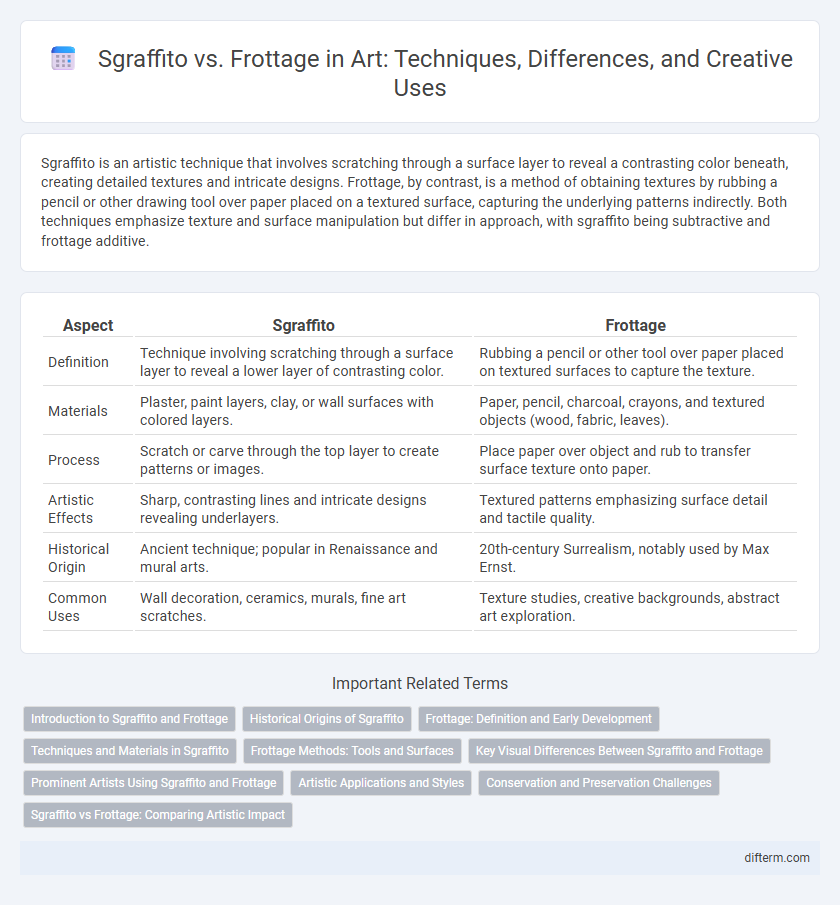Sgraffito is an artistic technique that involves scratching through a surface layer to reveal a contrasting color beneath, creating detailed textures and intricate designs. Frottage, by contrast, is a method of obtaining textures by rubbing a pencil or other drawing tool over paper placed on a textured surface, capturing the underlying patterns indirectly. Both techniques emphasize texture and surface manipulation but differ in approach, with sgraffito being subtractive and frottage additive.
Table of Comparison
| Aspect | Sgraffito | Frottage |
|---|---|---|
| Definition | Technique involving scratching through a surface layer to reveal a lower layer of contrasting color. | Rubbing a pencil or other tool over paper placed on textured surfaces to capture the texture. |
| Materials | Plaster, paint layers, clay, or wall surfaces with colored layers. | Paper, pencil, charcoal, crayons, and textured objects (wood, fabric, leaves). |
| Process | Scratch or carve through the top layer to create patterns or images. | Place paper over object and rub to transfer surface texture onto paper. |
| Artistic Effects | Sharp, contrasting lines and intricate designs revealing underlayers. | Textured patterns emphasizing surface detail and tactile quality. |
| Historical Origin | Ancient technique; popular in Renaissance and mural arts. | 20th-century Surrealism, notably used by Max Ernst. |
| Common Uses | Wall decoration, ceramics, murals, fine art scratches. | Texture studies, creative backgrounds, abstract art exploration. |
Introduction to Sgraffito and Frottage
Sgraffito is an artistic technique that involves scratching through a surface layer to reveal a contrasting color beneath, commonly used in ceramics and wall decoration. Frottage, developed by surrealist Max Ernst, is a method of creating textures by rubbing a pencil or crayon over a textured surface to capture its pattern on paper. Both techniques emphasize texture and surface manipulation, offering unique approaches to visual expression in art.
Historical Origins of Sgraffito
Sgraffito originated in classical antiquity, particularly prevalent in ancient Greek and Roman wall decorations, where artists scratched through a surface layer to reveal contrasting colors beneath. This technique gained significant prominence during the Renaissance, especially in Italian and Central European architecture, as a decorative method on facades and pottery. Its historical roots reflect a sustained tradition of textural depth and intricate design, distinguishing it from frottage, which emerged much later as a surrealist-inspired rubbing technique in the 20th century.
Frottage: Definition and Early Development
Frottage, a technique pioneered by Max Ernst in the 1920s, involves creating textures by rubbing a pencil or other drawing tool over a textured surface to capture its patterns on paper. This method emphasizes spontaneous texture creation and taps into subconscious imagery, aligning closely with Surrealist ideals. Unlike sgraffito, which uses scratching methods to reveal underlying layers in painting or pottery, frottage serves as a direct transfer of physical textures into the artistic medium.
Techniques and Materials in Sgraffito
Sgraffito involves layering contrasting colors of plaster, paint, or clay and then scratching through the top layer to reveal the underlying hue, creating intricate designs and textures. Artists often use tools such as knives, needles, or trowels to achieve fine lines and controlled patterns. This technique is commonly applied on walls, ceramics, and frescoes, emphasizing tactile depth and visual contrast through material manipulation.
Frottage Methods: Tools and Surfaces
Frottage employs textured surfaces and simple tools like pencils, charcoal, or crayons to capture intricate patterns by rubbing over materials such as wood grain, leaves, or fabric. Artists select diverse substrates like paper, canvas, or thin cardboard to enhance the depth and complexity of the frottage texture. This technique contrasts with sgraffito, which involves scratching layers of paint or plaster to reveal underlying colors and textures.
Key Visual Differences Between Sgraffito and Frottage
Sgraffito involves scratching through a surface layer to reveal a contrasting color beneath, creating sharp, linear textures with precise control. Frottage relies on rubbing paper over textured objects to transfer their patterns, producing spontaneous, organic, and unpredictable visuals. The key visual difference lies in sgraffito's deliberate incised lines versus frottage's textured, random impressions.
Prominent Artists Using Sgraffito and Frottage
Max Ernst, a pioneer of frottage, utilized this technique to create textured and surreal imagery by rubbing pencil over various surfaces, influencing the Surrealist movement extensively. Prominent artists using sgraffito include Giorgio Morandi and Frank Stella, who employed this scratch-through surface method to reveal underlying colors, adding depth and contrast in their works. Both techniques serve as powerful tools in experimental art, expanding textural possibilities and visual interest in 20th-century modernism.
Artistic Applications and Styles
Sgraffito involves scratching through a surface layer to reveal a contrasting color beneath, commonly used in ceramics, murals, and frescoes to create textured, detailed images. Frottage employs rubbing a pencil or other drawing tool over textured surfaces to capture patterns and forms, frequently embraced in surrealist art for its spontaneous, organic results. Both techniques emphasize texture and surface manipulation but differ in execution, with sgraffito relying on subtraction and frottage on impression.
Conservation and Preservation Challenges
Sgraffito, involving layered plaster or paint scratched to reveal underlying colors, faces conservation challenges due to its vulnerability to surface abrasion and moisture damage, requiring careful stabilization of fragile layers. Frottage, created by rubbing paper over textured surfaces, is susceptible to paper degradation and pigment fading, necessitating controlled environmental conditions to prevent acidification and light-induced deterioration. Both techniques demand specialized preservation strategies tailored to their unique material compositions and sensitivities.
Sgraffito vs Frottage: Comparing Artistic Impact
Sgraffito and frottage offer distinct artistic impacts through their unique techniques; sgraffito involves scratching through a surface layer to reveal underlying colors, creating sharp contrasts and intricate textures that emphasize depth and dimension. Frottage employs rubbing materials over textured surfaces to capture spontaneous patterns and organic forms, fostering a sense of randomness and tactile richness. The deliberate control in sgraffito contrasts with the chance-driven outcomes of frottage, influencing how artists convey texture, form, and emotional expression in their work.
sgraffito vs frottage Infographic

 difterm.com
difterm.com